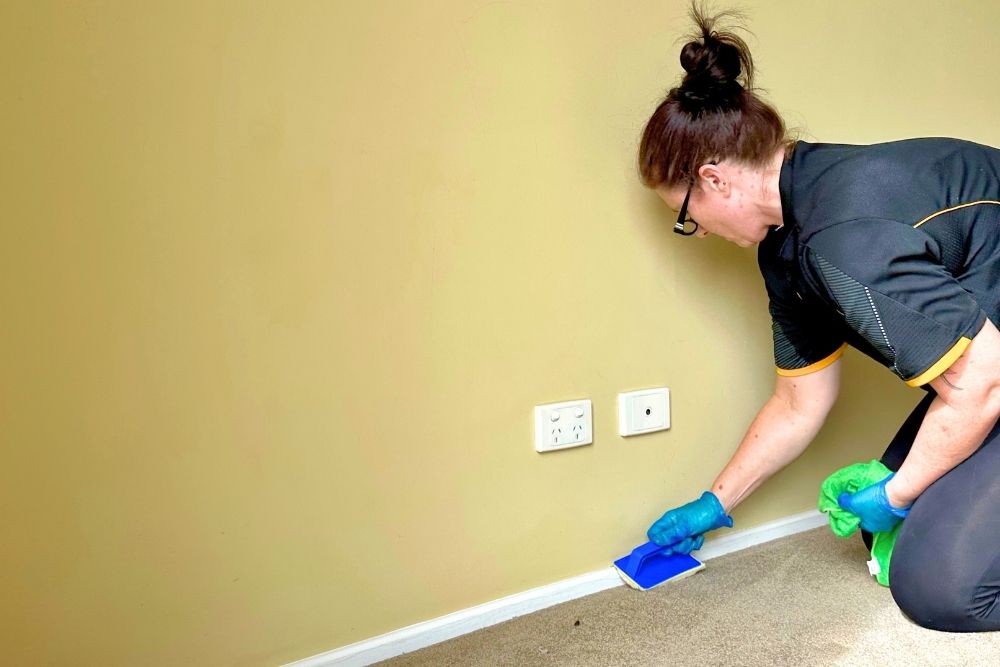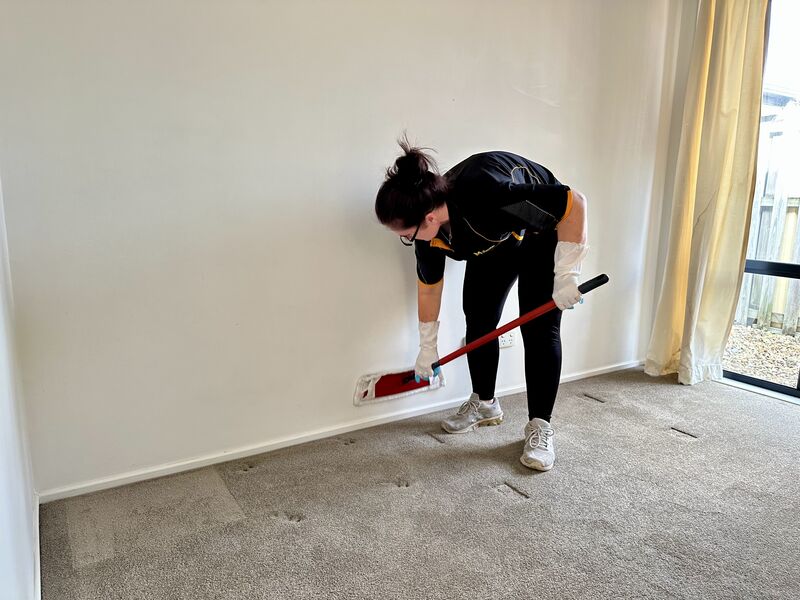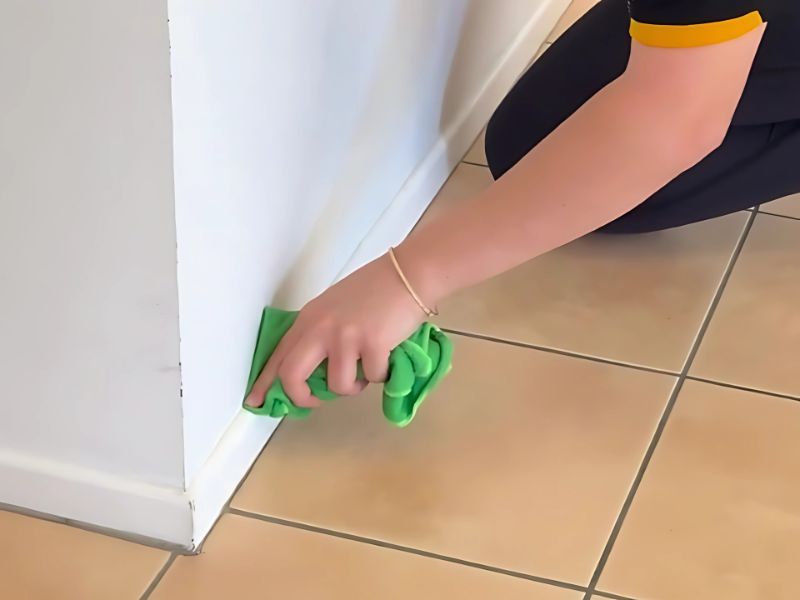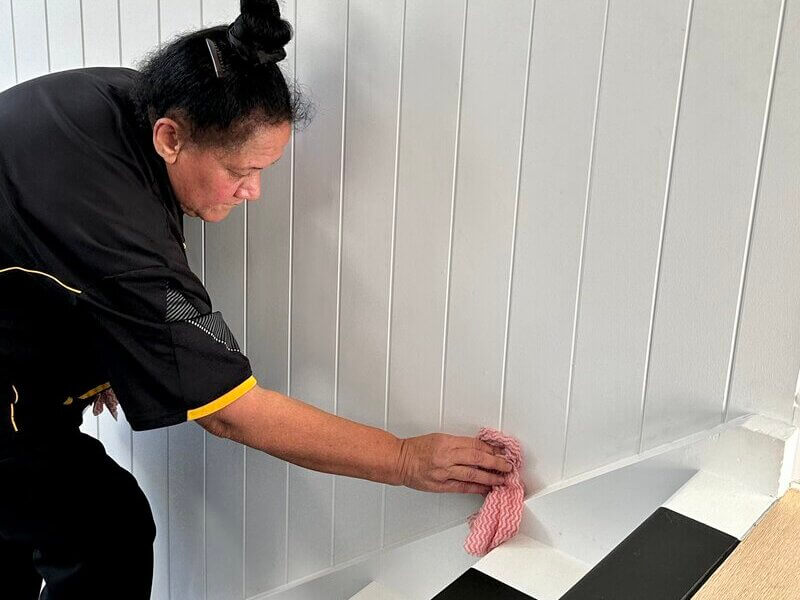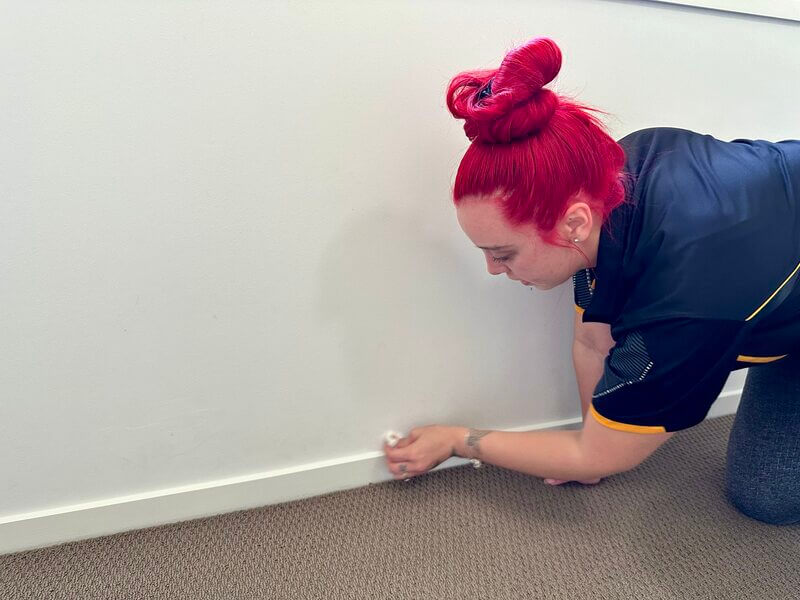Lots of us don’t like sweeping or mopping the floor — admit it! It’s tedious, and the dust keeps coming back, and the floor feels so big.
But while you’re looking down and inspecting the dirt that’s accumulated, ask yourself: when was the last time you washed the skirting boards?
It can be tempting to leave them be. The boards aren’t at eye level, so who would notice? (You would, that’s who.) But just like dirty grout lines, dirty skirting boards can make a floor (and wall) look bad, too.
To clean skirting boards, use a dust mop or vacuum once a week to remove loose dirt. Then wash them with soapy water, vinegar, or sugar soap once every 1–2 months.
You wouldn’t like dirty hems on your clothing, so don’t do the same with the skirting boards on your walls! With a little time and elbow grease, you’ll get them sparkling again.
How Often to Clean | What to Clean With | Routine Cleaning | Deep Cleaning | Cleaning White Skirting Boards | Removing Stains | Maintenance Tips
Why Do Skirting Boards Get So Dirty?
The same reason as your floors — they’re close to the ground!
Since skirting boards (also called baseboards) are positioned so low, they tend to collect dust and dirt that falls downwards or gets stirred up by your feet or your pets.
They can get dirty quickly in rooms with high traffic (like hallways or living rooms), or when they’re underneath windows. Meanwhile, spills in kitchens or dining rooms can lead to stains.
Materials like wood can also attract dust due to static electricity, especially in dry weather!
How Often Should You Clean Skirting Boards?
Lightly clean your skirting boards once a week to minimise the buildup of dust and dirt. You can stretch this to every two weeks if your schedule is busy, or if the boards aren’t too dirty!
Deep clean the skirting boards once a month, or once every 1–2 months for low-traffic areas. This lets you tackle deep-seated dirt and get the boards looking like new again.
Tidy up stains or messes immediately, so they don’t set. The longer you leave them, the harder they’ll be to remove — and food messes could potentially attract pests, too. (Ew.)
If the never-ending cleaning routine feels like a headache, leave your baseboards, walls, and floors to a Maid2Match house cleaner instead!
What to Clean Skirting Boards With?
Skirting boards are typically made of either wood or vinyl, so your chosen cleaning method will depend on the material!
For the most part, though, you can use one of these solutions to clean skirting boards:
- Dish soap and water
- White vinegar
- Wood cleaner
- Sugar soap
Besides that, you’ll need a long-handled duster or dust mop (like the flexible O-Cedar Microfibre Dust Mop), or a vacuum cleaner with a soft brush attachment (crevice attachment optional).
To clean your skirting boards without bending, use a baseboard mop like this JEHONN Wall Mop or Qaestfy Wall & Baseboard Mop. These have long, adjustable handles and contoured mop heads that fit along the walls.
Otherwise, use microfibre cloths or soft sponges to scrub the surfaces.
Don’t forget to have 2 buckets (to hold your cleaning solution and rinse water) and microfibre cloths or towels (for drying)!
As for what not to use on skirting boards, avoid highly-abrasive cleaners like steel wool, which could create scuff marks or scratches that trap dirt. Skip harsh cleaners like bleach as well, unless necessary.
Routine Cleaning for Skirting Boards
For routine, light cleaning, your main goal is to remove dust and debris to minimise buildup!
Use a long-handled duster, dust mop, or vacuum cleaner to go along the full length of the skirting boards. For the vacuum, use a brush attachment along the boards and a nozzle for the corners.
Make sure you work on the baseboards before sweeping or mopping your floors, so you can clean up all the dirt later.
For any mild streaks or scuff marks, you can wipe them off using wet wipes or a damp cloth. Remember to dry the damp spots afterwards.
How to Deep Clean Skirting Boards
Dusting keeps the dirt at bay, but grime can still build up over time. Skirting boards will need deep cleaning every 1–2 months, so pick your product and get them shining!
Before you get to work, use a dust mop or vacuum cleaner to remove any dust and loose dirt from the skirting boards. That way, you’re not pushing the grime around while cleaning.
Make sure you wear rubber gloves and eye protection while working!
Using soap and water
Sometimes the simplest methods are the most effective. Warm, soapy water is one of the best ways to clean skirting boards.
In a bucket, mix a few drops of dish soap with warm (or barely hot) water. Dip your baseboard mop or a soft cloth into the solution, then wring it out so it’s just damp — you don’t want too much moisture, especially on wood.
Start from one end or corner, and use short, back-and-forth strokes over one section at a time. Pay special attention to extra dirty or stained areas.
Once one section is finished, rinse off the residue with a damp cloth or new mop pad dipped in fresh water. Finish with a clean cloth or mop to dry, then continue down the wall.
NOTE: A mild laundry detergent is a good alternative, but skip the fabric conditioner! This can leave a residue that will attract more dirt — the opposite of what you want.
Using white vinegar
White vinegar is a versatile cleaner, and it works on vinyl or painted wood skirting boards as well. Avoid it on sealed wood, however, as it can discolour or cloud the finish.
Mix one cup of vinegar per 3 litres of warm water in a bucket. Dip your mop or soft sponge into the cleaning solution, then wring out the excess.
Work in small sections, wiping with back-and-forth strokes. Once you’ve cleaned one section, rinse off the residue with a cloth or mop pad dampened with clean water, then immediately dry the area.
Keep going down the wall until the boards are fully clean.
Using wood cleaner
Another option for cleaning timber skirting boards is a good wood soap or cleaner, such as the Weiman Hardwood Floor Cleaner or Method Squirt + Mop Hardwood Cleaner.
Follow the product instructions for mixing with water and applying to the wood skirting boards. Remember to minimise the use of moisture, since it could cause the material to warp or swell.
Once you’ve cleaned the boards and rinsed off any residue, dry them ASAP! This helps prevent water spots and buffs the surface for a sleek appearance.
You can even apply a wood conditioner like Howard Feed-N-Wax Wood Polish & Conditioner! These products stop the wood from drying while leaving a soft sheen.
Using sugar soap
Sugar soap is another effective skirting board cleaner, especially in the kitchen — it can scrub off grease and remove tough stains. And yes, it’s safe to use sugar soap to clean sealed wood!
Do not use it on flat or matte painted boards, though, as it can burnish or scuff the finish.
When cleaning with sugar soap (like Selleys), follow the product instructions for dilution. For general use, it’s typically 1 part sugar soap to 10 parts warm water.
Apply it to the surface using a microfibre cloth or baseboard mop. Work in small sections, then rinse each section ASAP once it’s been scrubbed clean.
For very dirty or greasy skirting boards, leave the sugar soap solution on for 30–60 minutes before scrubbing.
Rinse the surfaces, then wipe them dry afterwards.
Using a steam cleaner
You can use a steam cleaner (or handheld steam mop) for vinyl or sealed timber — if the manufacturer allows it! Always check the manual or your manufacturer’s instructions beforehand.
Do not use steam cleaners on fibreboard and other layered boards, as the heat and steam could melt the adhesive and cause the material to warp or swell. Excess moisture can also lead to mould.
Also, test the steam cleaner on an inconspicuous corner first to make sure it won’t cause damage!
When ready, switch on the steam cleaner to the lowest allowable setting and run it along the skirting board. Work in small sections and dry each one immediately afterwards.
How to Clean White Skirting Boards
White skirting boards look classy, but they can be tricky to maintain since any scuffs and stains are easily visible.
Your best bet to get white skirting boards looking like new is white vinegar, which can brighten surfaces.
Mix a cup of vinegar in a bucket of warm water. Dip in a mop or microfibre cloth, then wring it out thoroughly before using it to clean along the boards.
Tackle stains with a stronger solution of equal parts vinegar and water, plus a soft sponge. Do not use hydrogen peroxide, which reacts with paint to discolour or damage the finish.
Rinse the surfaces clean with a mop dipped in just water, then dry them thoroughly with an old towel.
How to Remove Stains from Skirting Boards
Food, grease, mud, and even scuffs can leave stains on your skirting boards. If you let it linger, a stain can set and discolour or damage the finish.
For small stains on vinyl boards, try a magic eraser! The abrasive material can scrub off any marks quickly and easily.
Avoid it on wood boards, as it can scratch paint, wax, and other finishes. Instead, you can use a baking soda paste, which is milder.
Mix baking soda with a little water, then apply the paste to the affected area. For more cleaning power, add a few drops of liquid soap.
Gently scrub the stain off with a damp sponge or cloth, then rinse off the residue and dry the surface.
For very stubborn stains and tough grime, use sugar soap. Follow the product instructions for general cleaning, and don’t forget to rinse and dry the surface afterwards to remove any residue.
Tips for Cleaning and Maintaining Skirting Boards
For grooves and crevices, try a cotton bud! The tiny tip will fit better than a mop head or sponge. You can also use an old grout brush or toothbrush.
Make sure to rinse and dry the boards after washing so the moisture doesn’t seep inside. Excess moisture can lead to swelling, warping, loosened adhesive, and even mould or mildew.
Use a dryer sheet afterwards — yes, really! After cleaning your skirting boards (whether that’s dusting or washing), rub them with some dryer sheets to deter static buildup of dust.
The sheets can also remove odours from cleaning solutions (like vinegar).
If you’re cleaning the walls alongside the boards, tackle the walls first. You don’t want any dirt to drip down onto already-clean surfaces!
For sealed wood and paint, check how often you need to re-seal the material. Re-sealing protects your skirting boards and keeps them looking fresh for longer.

